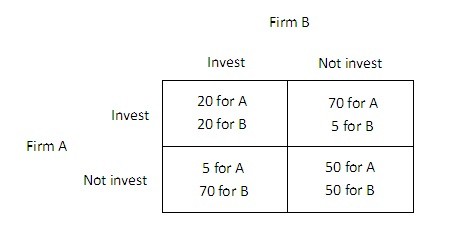You are a hotel manager and you are considering four projects that yield different payoffs, depending upon whether there is an economic boom or a recession. The potential payoffs and corresponding payoffs are summarized in the following table.ProjectBoom (50%)Recession (50%)A$20-$10B-$10$20C$30-$30D$50$50The variance in the returns of project D is:
A. 900.
B. 1,600.
C. 225.
D. 0.
Answer: D
You might also like to view...
The payoff matrix below shows the payoffs (in millions of dollars) for two firms, A and B, for two different strategies, investing in new capital or not investing in new capital.  An industry spy from firm A comes to firm B and offers to pay B in exchange for B's certain and enforceable promise to not invest. What is the most that firm A will be willing to pay B to not invest?
An industry spy from firm A comes to firm B and offers to pay B in exchange for B's certain and enforceable promise to not invest. What is the most that firm A will be willing to pay B to not invest?
A. $30 million. B. $50 million. C. $20 million. D. $35 million.
The Law of Demand is the reason behind:
A) the price elasticity of demand having a positive value. B) the income elasticity of demand having a positive value. C) the price elasticity of demand having a negative value. D) the income elasticity of demand having a negative value.
Consider the above table. Assuming the government imposes a price floor on garbanzo beans of $8, what would be the likely result?
A) a surplus of 2000 garbanzo beans B) a shortage of 2000 garbanzo beans C) No change, equilibrium would prevail. D) The quantity demanded of garbanzo beans would fall to zero.
Economists normally
a. do not try to explain people's tastes, but they do try to explain what happens when tastes change. b. believe that they must be able to explain people's tastes in order to explain what happens when tastes change. c. do not believe that people's tastes determine demand, so they ignore the subject of tastes. d. incorporate tastes into economic models only to the extent that tastes determine whether pairs of goods are substitutes or complements.